Overview
The article titled "7 Advanced Solar Inverter Technologies Enhancing Energy Efficiency" addresses the crucial role of advanced solar inverter technologies in improving energy efficiency within solar power systems. It underscores key innovations such as:
- Maximum Power Point Tracking (MPPT)
- Smart inverters
- AI integration
These technologies are not merely enhancements; they significantly elevate the performance, reliability, and integration of solar energy into the grid. This progress is vital for fostering a more sustainable energy future, urging stakeholders to recognize the transformative potential of these advancements.
Introduction
The rapid evolution of solar technology is fundamentally reshaping the energy landscape. Advanced solar inverter technologies are pivotal in enhancing energy efficiency, optimizing power generation, and ensuring seamless integration into existing energy grids. This progress paves the way for a more sustainable future.
However, as the demand for renewable energy surges, developers and homeowners face critical questions:
- How can they leverage these cutting-edge technologies to maximize their benefits?
- What strategies can be employed to mitigate potential challenges?
Harbinger Land | Advanced Title Research Solutions for Solar Projects
Harbinger Land stands at the forefront of advanced title research solutions tailored specifically for renewable energy projects. In an era where compliance with legal and regulatory requirements is paramount, their AI-powered title research software significantly streamlines the process through rigorous quality control measures. This innovative approach not only accelerates project initiation but also mitigates the risk of legal conflicts, positioning it as an indispensable service for developers focused on timely project execution.
Consider the impact: case studies reveal that projects utilizing this technology have experienced a reduction in initiation time by up to 30%. This efficiency empowers developers to swiftly capitalize on favorable market conditions. As the demand for renewable power surges—forecasts indicate it could account for 48% of total power production by 2050—the necessity for effective title research and document imaging becomes increasingly critical.
Developers have recognized that leveraging AI in title research not only enhances operational efficiency but also significantly contributes to overall project success. To fully harness these advantages, energy developers are strongly encouraged to integrate advanced title research and document imaging solutions into their project planning processes. By doing so, they can navigate the complexities of land acquisition with confidence and precision.
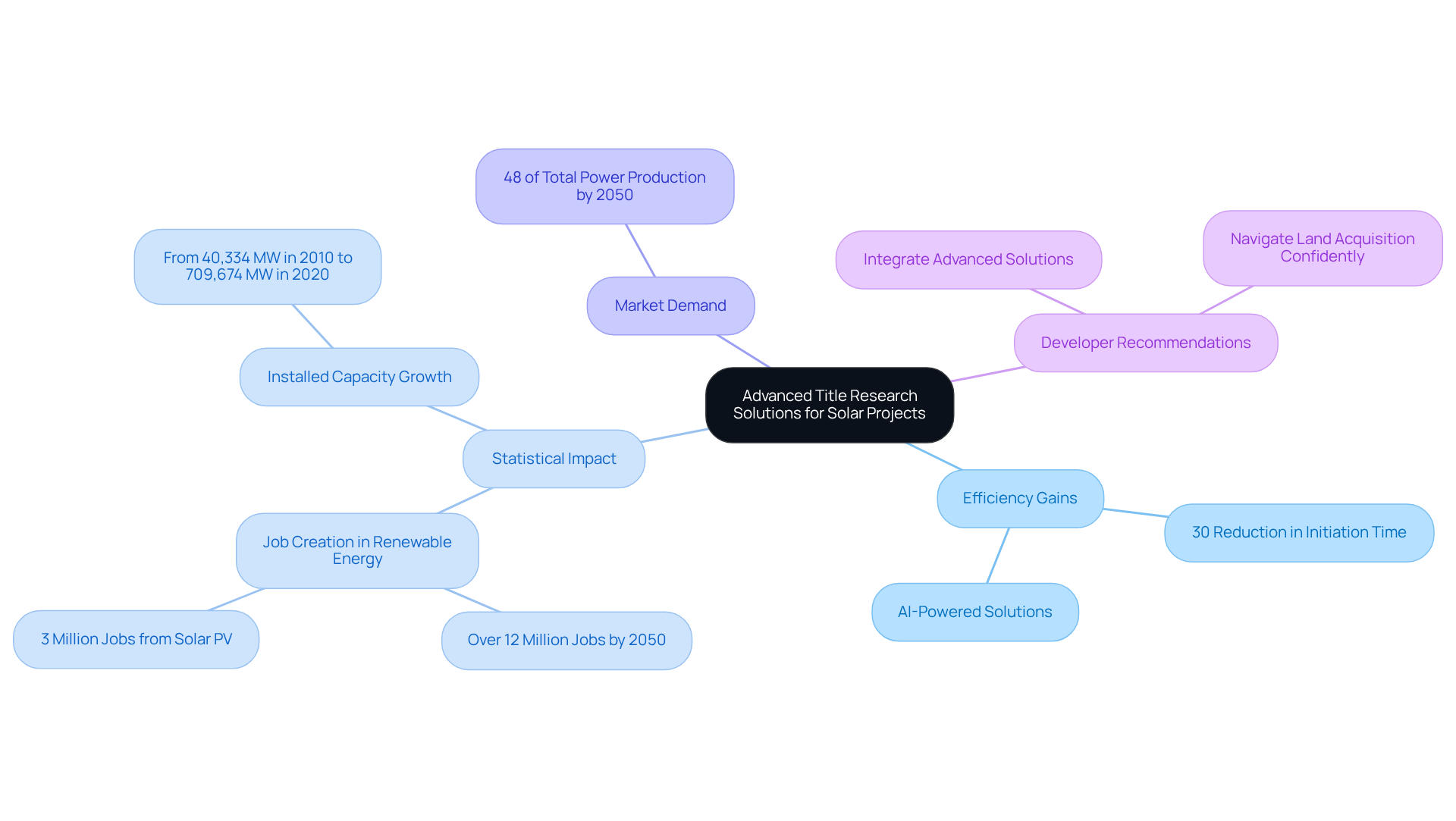
Maximum Power Point Tracking (MPPT): Optimizing Solar Energy Output
Maximum Power Point Tracking (MPPT) stands as a pivotal algorithm in photovoltaic systems, designed to significantly enhance the output from solar panels. By continuously adjusting the electrical operating point of the modules, MPPT ensures that the system operates at peak efficiency, especially under fluctuating environmental conditions. This innovative technology, particularly advanced solar inverter technologies, can elevate electricity generation by up to 30%, underscoring its essential role in modern photovoltaic converter design. As the energy landscape evolves, embracing MPPT technology is not just beneficial; it is imperative for maximizing energy production and achieving sustainability goals.
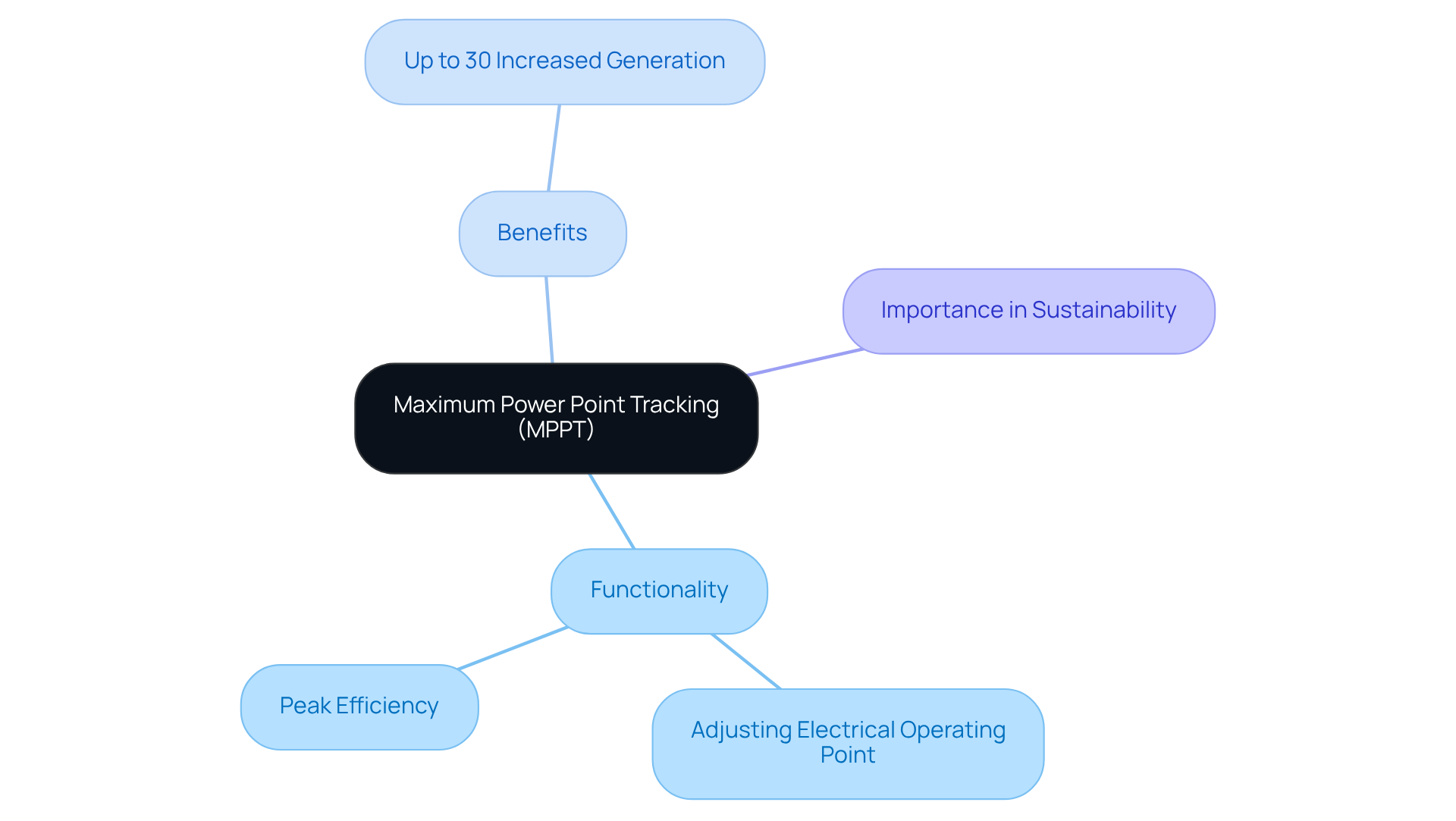
Smart Inverters: Enhancing Grid Integration for Solar Energy
Intelligent devices utilizing advanced solar inverter technologies are revolutionizing the integration of solar power into the energy network with their advanced communication capabilities, enabling real-time interaction with grid systems. These devices can dynamically adjust their output in response to fluctuating grid conditions, providing essential services such as voltage regulation and frequency support.
For instance, in various initiatives, intelligent devices have successfully maintained grid stability by managing voltage fluctuations, underscoring their vital role in enhancing the reliability of renewable energy systems. As grid expert Paul Chiao asserts, 'Intelligent converters are essential for guaranteeing that renewable power can be efficiently merged into our current framework.'
This adaptability not only streamlines the incorporation of advanced solar inverter technologies into existing infrastructure but also establishes a foundation for a more sustainable energy future. As the renewable energy sector continues to grow, the deployment of intelligent devices is expected to be pivotal in achieving the ambitious goal of renewable energy constituting 50% of global electricity production by 2050.
Additionally, U.S. homeowners benefit significantly, saving an average of $1,500 annually through photovoltaic installations, further emphasizing the economic advantages of integrating intelligent power conversion technology.
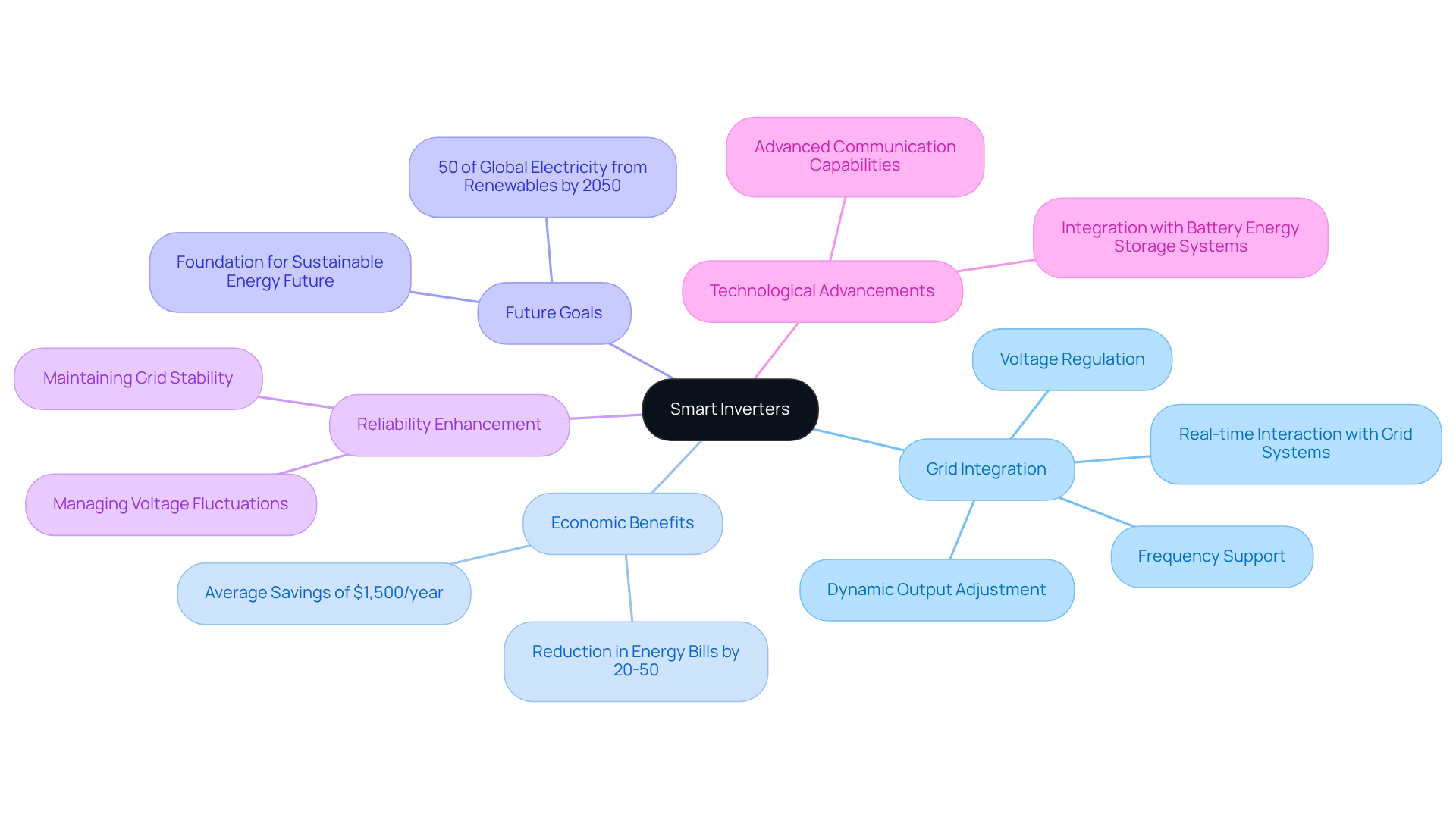
Safety Features in Advanced Solar Inverters: Ensuring System Integrity
Sophisticated photovoltaic converters are equipped with essential safety features that safeguard both the system and its operators. A critical component is anti-islanding protection, which prevents the device from feeding power back into the grid during outages, thereby averting potential hazards. This feature is vital for maintaining grid stability and ensuring the safety of utility workers during maintenance operations. Furthermore, arc fault detection is integrated to identify and mitigate fire risks, significantly enhancing safety.
Data from PowerOutage.us indicates that inverters outfitted with these advanced safety features substantially reduce the likelihood of electrical incidents, fostering greater user confidence in renewable energy solutions. Real-world applications underscore the efficacy of anti-islanding protection; for instance, during the Public Safety Power Shutoff program initiated by PG&E in California, homeowners with compliant renewable energy systems enjoyed an uninterrupted power supply, demonstrating the reliability of these technologies.
Moreover, safety authorities emphasize that adherence to stringent safety standards is crucial for preserving the integrity of renewable power installations. By incorporating sophisticated safety features, photovoltaic converters play a pivotal role in creating a more secure power landscape while enhancing overall system reliability.
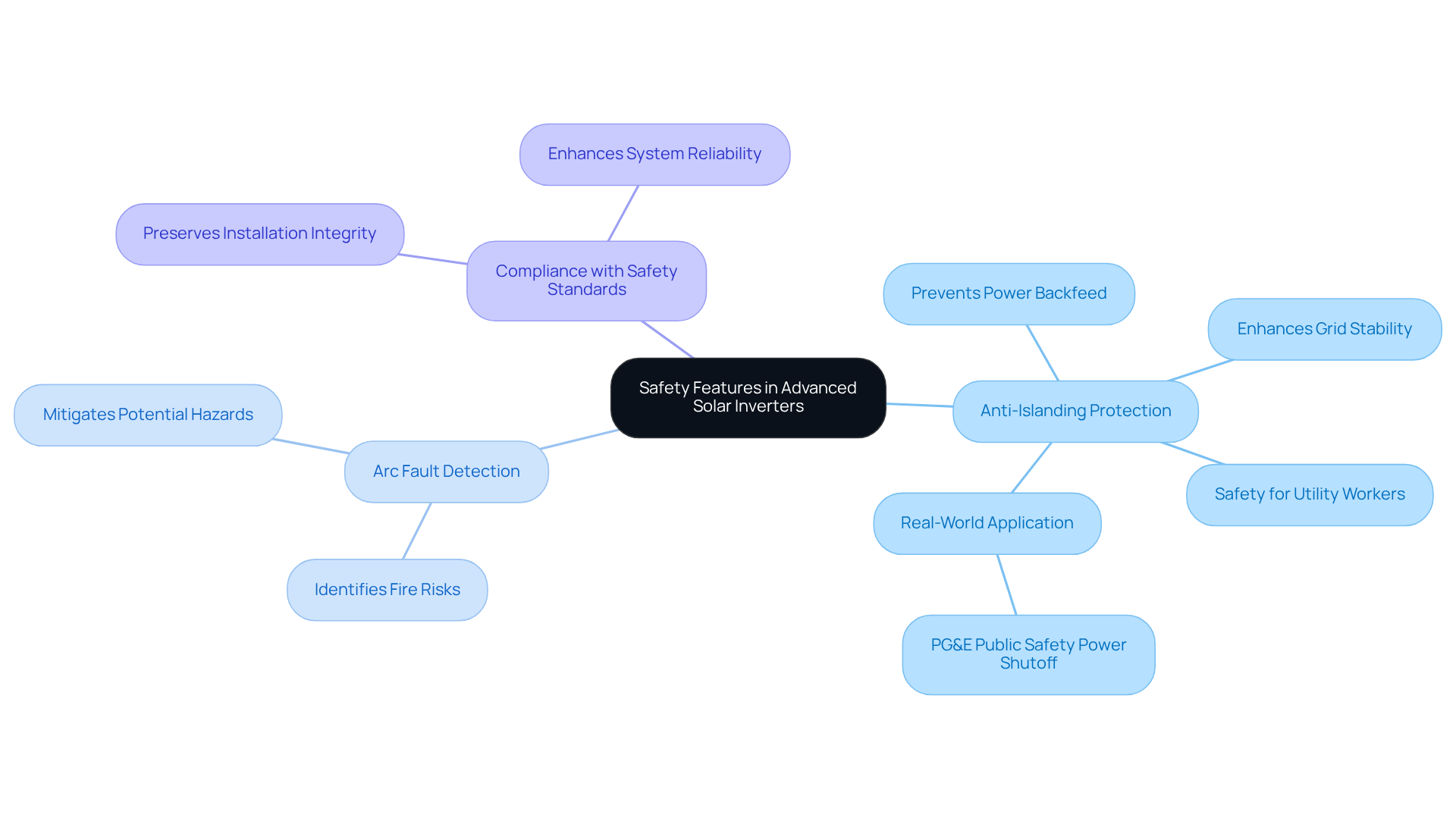
DC to AC Conversion Efficiency: Key to Solar Inverter Performance
The efficiency of DC to AC conversion stands as a pivotal metric in assessing photovoltaic devices, with modern models achieving efficiencies exceeding 98%. This exceptional performance underscores that nearly all energy produced by solar panels is converted into usable AC power. Several key factors influence this efficiency, including converter design, component quality, and operating conditions. For instance, the Leonics G-304 device model averages an efficiency of approximately 0.90, aligning closely with the manufacturer's specification of 0.91, thereby demonstrating consistent performance across varying conditions.
However, efficiency can be adversely affected by low irradiance conditions, where operating at partial load leads to increased losses. Notably, an unexpected malfunction in one converter within a facility housing ten converters can result in a loss of around 10 percent of the plant's energy production. To mitigate such risks, selecting high-quality converters utilizing advanced solar inverter technologies enables developers to significantly enhance the performance and power output of their installations, thereby ensuring a more reliable and effective power solution.
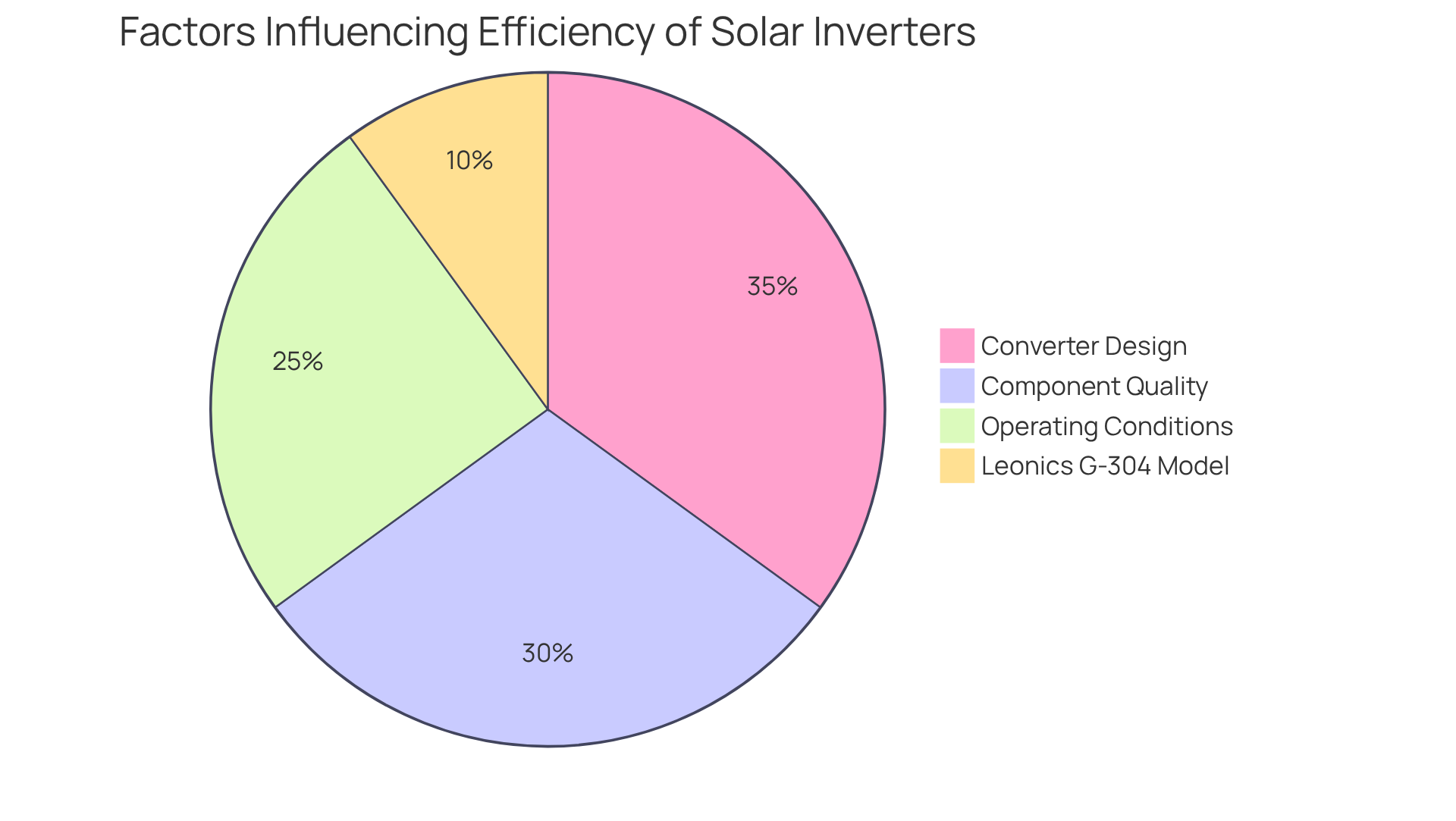
Advanced Power Electronics: Boosting Solar Inverter Reliability
Advanced power electronics are pivotal in enhancing the reliability of photovoltaic converters. Innovations such as wide-bandgap semiconductors significantly improve efficiency and thermal performance, which in turn reduces the risk of overheating and failure. These advancements not only extend the overall longevity of converters but also contribute to improved power conversion and network stability. Such features are crucial for the success of large-scale photovoltaic projects, positioning these technologies as essential for future energy solutions.
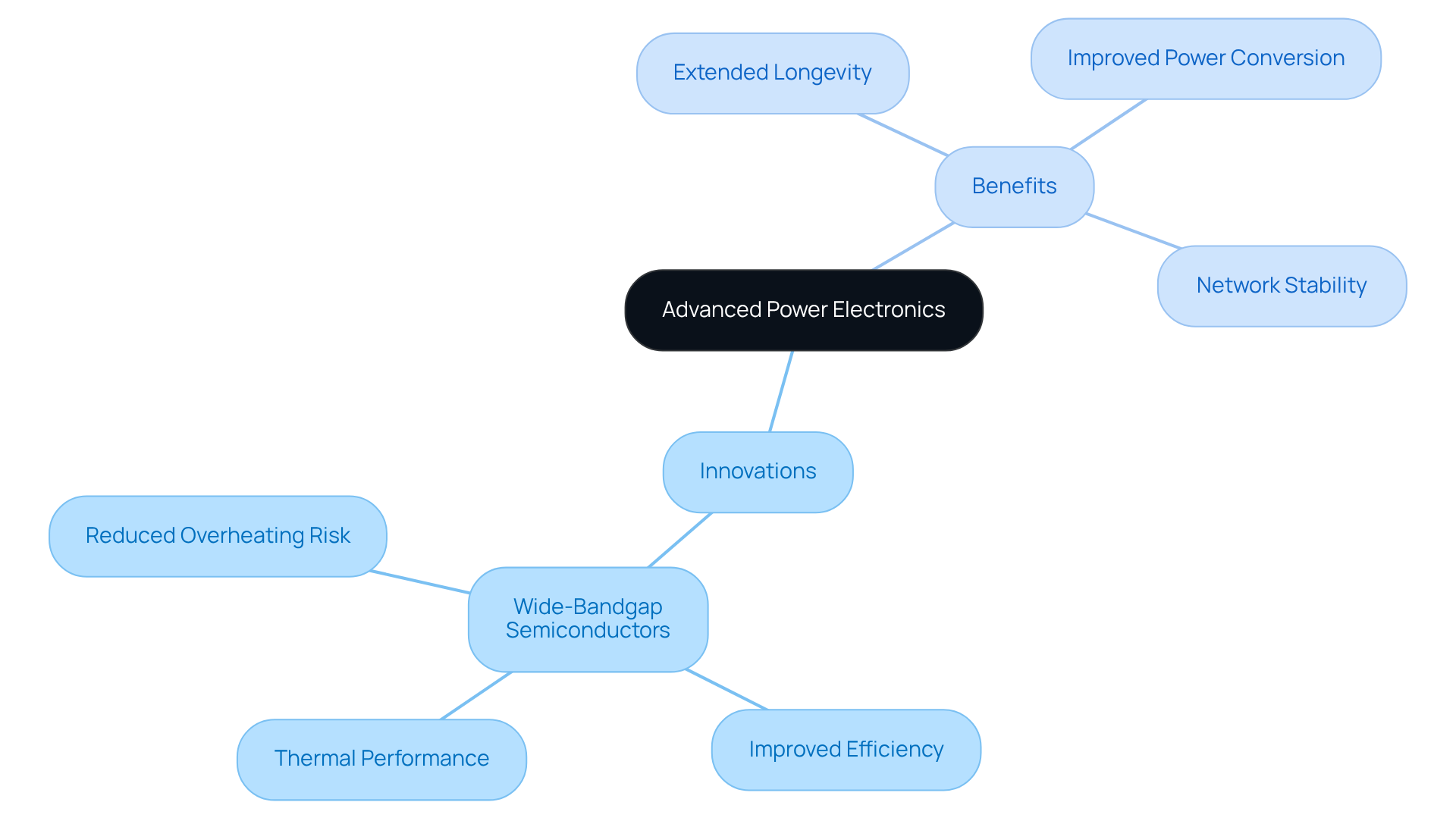
AI Integration: Revolutionizing Solar Inverter Monitoring and Efficiency
The integration of artificial intelligence (AI) into solar devices is fundamentally transforming their operational capabilities. AI algorithms excel at analyzing real-time data, which enhances power generation, enables proactive maintenance forecasts, and improves overall performance. By continuously learning from operational data, AI-driven inverters can adapt to fluctuating environmental conditions, ensuring peak efficiency and reliability. This groundbreaking technology not only boosts power output but also significantly reduces operational expenses, marking a crucial advancement for photovoltaic systems.
For instance, the National Renewable Energy Laboratory (NREL) is actively modeling the impact of AI on operations and maintenance (O&M) expenses, demonstrating its potential to lower the levelized cost of power for photovoltaic installations. Furthermore, a recent Deloitte survey reveals that 97% of utilities prioritize clean energy sources, underscoring the importance of AI in the transition to sustainable power solutions. As the demand for clean energy intensifies, the role of AI in optimizing solar energy production becomes increasingly critical, paving the way for more sustainable energy solutions.
Moreover, ongoing collaborations between NREL, Sandia National Laboratories, and Lawrence Berkeley National Laboratory are focused on enhancing the operational efficiency of photovoltaic systems. This collective effort exemplifies the commitment to leveraging AI for improved performance, ultimately driving the industry toward a more sustainable future.
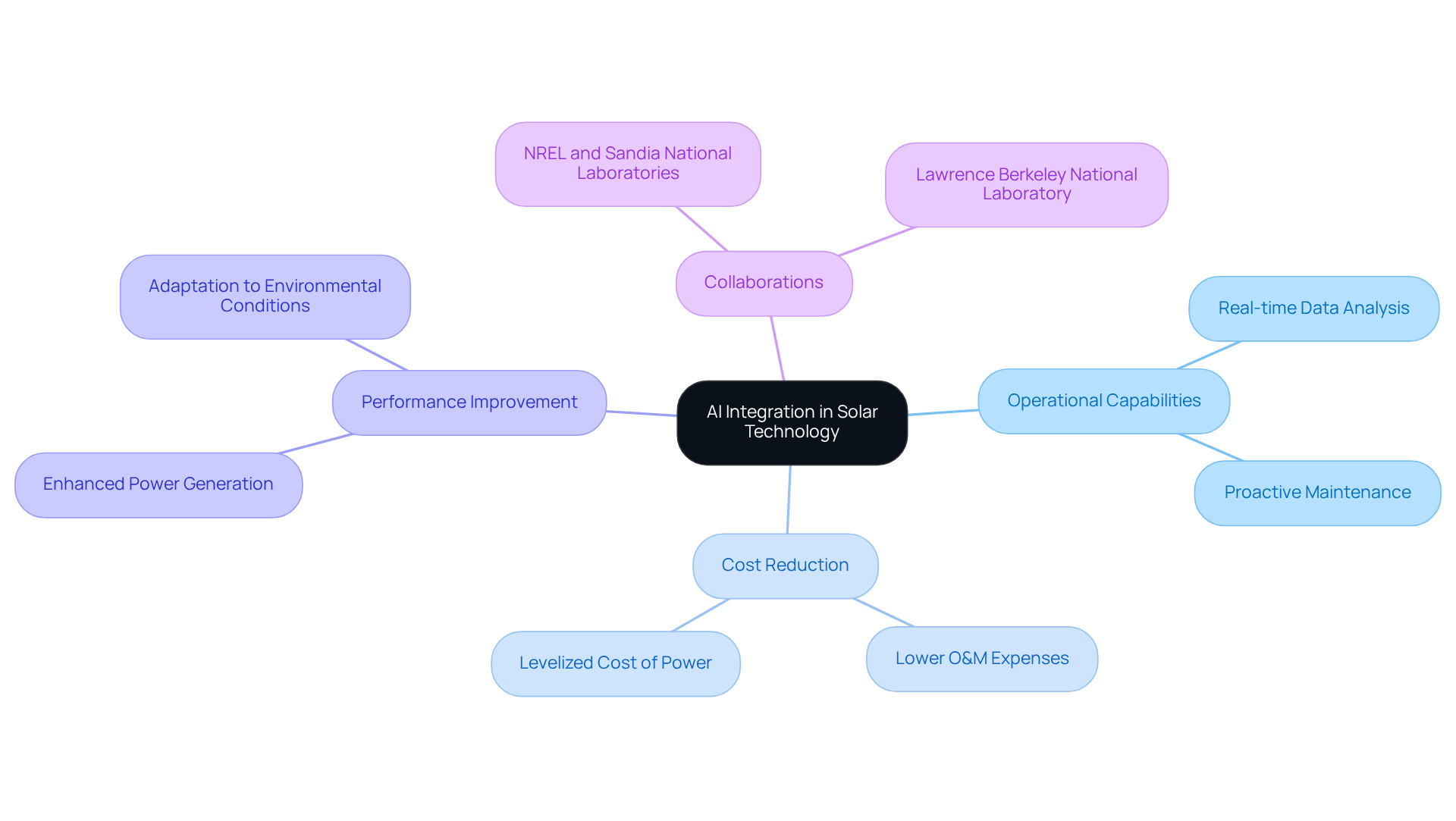
Grid Services: Supporting Stability with Solar Inverter Technologies
Solar devices are not merely converters; they serve a critical role in delivering essential grid services that enhance stability and reliability. By providing reactive power assistance and frequency management, these devices help maintain the delicate balance between supply and demand on the grid. This capability is increasingly vital as more renewable power sources are integrated, ensuring that sunlight-based power can effectively contribute to a stable and resilient power system.
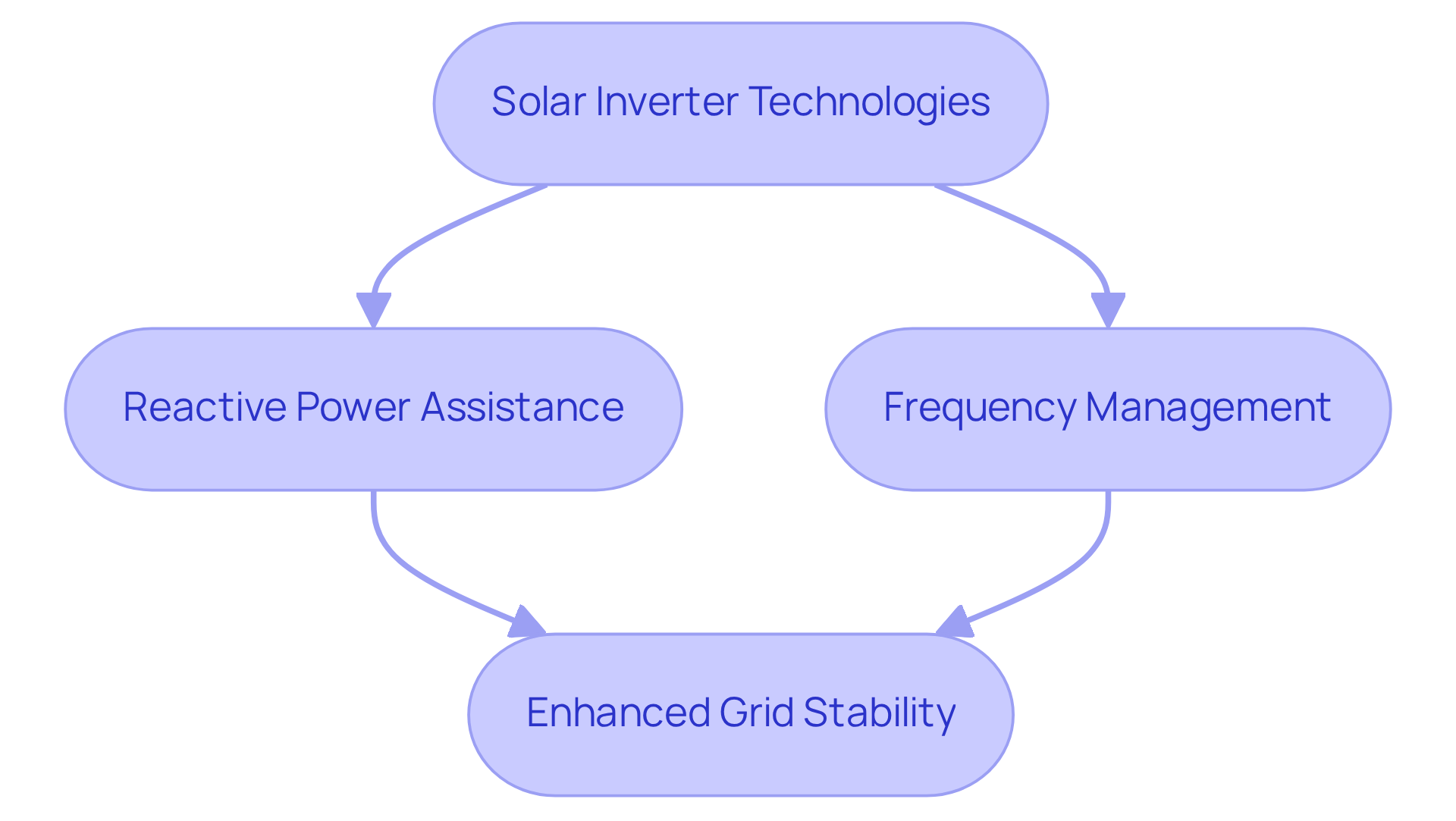
Future Trends in Solar Inverter Technologies: Innovations Driving Efficiency
The future of photovoltaic converter technology is poised for significant advancements, particularly through the implementation of advanced solar inverter technologies, along with innovations such as:
- Advanced AI functionalities
- Improved power storage integration
- Development of hybrid converters
These trends promise not only to enhance efficiency but also to broaden the capabilities of inverters, enabling them to better facilitate grid integration and energy management. As the solar market evolves, it is essential for developers and investors to stay informed about these trends, ensuring they remain competitive and effective in their strategies.
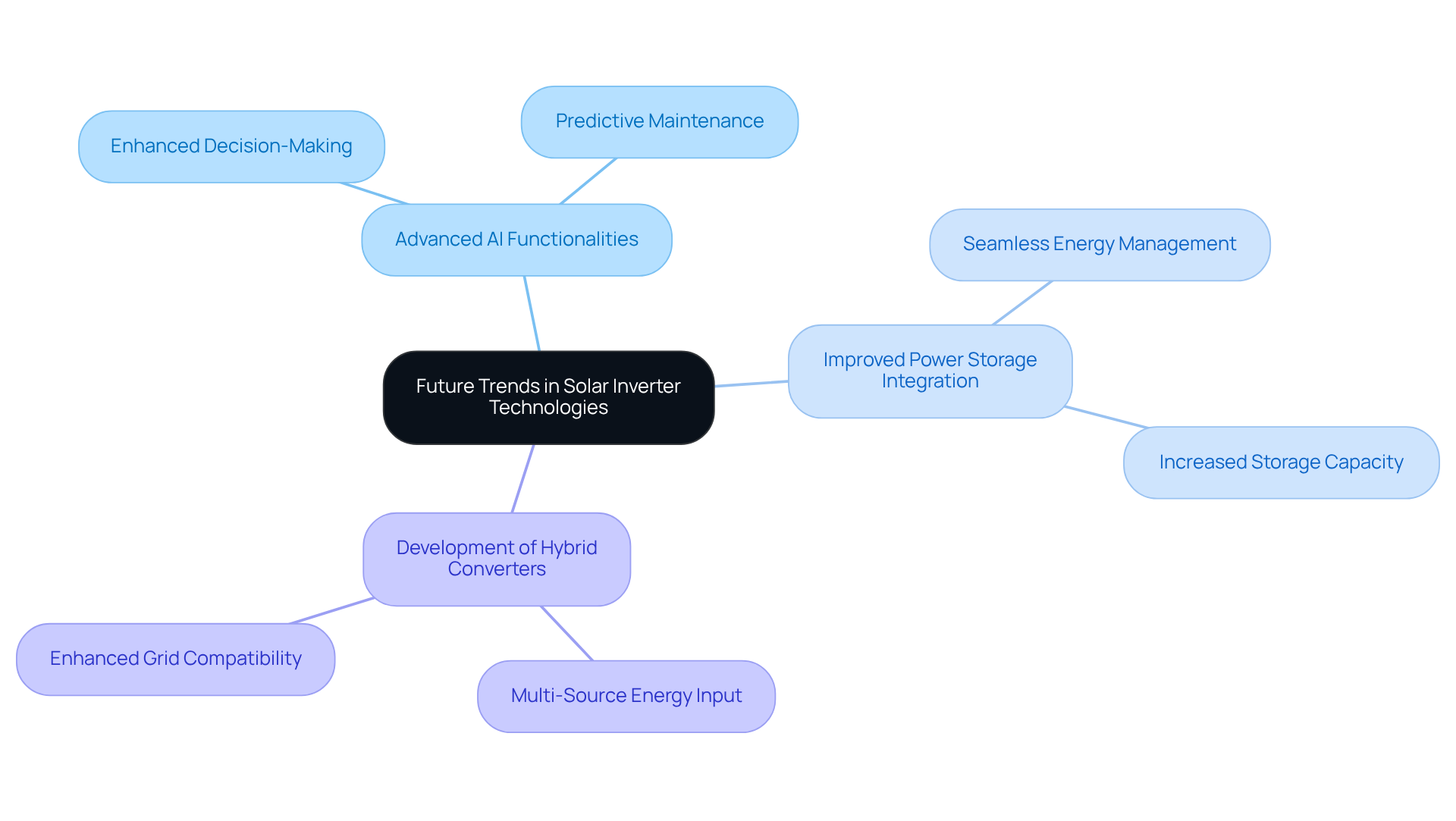
Conclusion
The advancements in solar inverter technologies are revolutionizing the renewable energy landscape, making it imperative for developers to adopt innovative solutions that enhance both efficiency and reliability. By integrating technologies such as Maximum Power Point Tracking (MPPT), smart inverters, and advanced safety features, the solar industry is not only optimizing energy output but also ensuring system integrity and grid stability. These developments highlight the necessity of embracing cutting-edge technologies to meet the surging demand for sustainable energy solutions.
Key insights from the article demonstrate that technologies like AI integration and advanced power electronics are crucial in enhancing the performance and operational efficiency of solar inverters. The capability of smart inverters to interact with the grid and deliver essential services, such as voltage regulation, is vital for the successful integration of solar power into existing energy systems. Moreover, the focus on safety features guarantees that these systems operate securely, mitigating risks associated with renewable energy installations.
In conclusion, as the momentum for renewable energy escalates, staying abreast of the latest advancements in solar inverter technologies is essential for both developers and investors. Embracing these innovations not only improves project execution and efficiency but also contributes to a more sustainable energy future. The time to act is now; integrating advanced solar technologies will pave the way for a resilient and efficient energy landscape that meets the demands of tomorrow.
Frequently Asked Questions
What is Harbinger Land and what services does it provide?
Harbinger Land offers advanced title research solutions specifically designed for renewable energy projects, utilizing AI-powered software to streamline the title research process while ensuring compliance with legal and regulatory requirements.
How does Harbinger Land's technology benefit energy developers?
The technology significantly reduces project initiation time by up to 30%, allowing developers to quickly take advantage of favorable market conditions and mitigating the risk of legal conflicts.
Why is title research important for renewable energy projects?
Effective title research is critical for navigating the complexities of land acquisition, ensuring compliance, and enhancing the overall success of energy projects as the demand for renewable power increases.
What is Maximum Power Point Tracking (MPPT) and why is it important?
MPPT is an algorithm in photovoltaic systems that optimizes the output from solar panels by adjusting their electrical operating point, enhancing electricity generation by up to 30%, which is essential for maximizing energy production.
How do smart inverters enhance grid integration for solar energy?
Smart inverters utilize advanced communication capabilities to interact with grid systems in real-time, adjusting their output to maintain grid stability and providing services such as voltage regulation and frequency support.
What are the economic benefits of integrating intelligent power conversion technology for homeowners?
U.S. homeowners can save an average of $1,500 annually through photovoltaic installations that utilize intelligent power conversion technology, highlighting the economic advantages of these systems.
What is the future outlook for renewable energy production?
The renewable energy sector is expected to grow significantly, with forecasts indicating that it could account for 50% of global electricity production by 2050, making the deployment of advanced technologies like smart inverters and MPPT crucial.
List of Sources
- Harbinger Land | Advanced Title Research Solutions for Solar Projects
- Solar energy technology and its roles in sustainable development (https://academic.oup.com/ce/article/6/3/476/6606003)
- Smart Inverters: Enhancing Grid Integration for Solar Energy
- A snapshot of the stats from the 2024 Renewable Report — RatedPower (https://ratedpower.com/blog/statistics-renewable-report-2024)
- 90+ Solar Energy Statistics: The Green Gold Rush (2025) - Enkonn Solar (https://enkonnsolar.com/solar-energy-statistics)
- Safety Features in Advanced Solar Inverters: Ensuring System Integrity
- How does a solar inverter work? (Functions, types, and benefits) (https://poweroutage.us/solar/solar-technology/solar-inverter)
- Staying Powered Up: The Truth About Solar Panels During Power Outages (https://solarinsure.com/staying-powered-up-the-truth-about-solar-panels-during-power-outages)
- DC to AC Conversion Efficiency: Key to Solar Inverter Performance
- Managing solar asset performance with connected analytics | ABB (https://new.abb.com/news/detail/25216/managing-solar-asset-performance-with-connected-analytics)
- Analysis of factors affecting efficiency of inverters: Case study grid-connected PV systems in lower northern region of Thailand (https://sciencedirect.com/science/article/pii/S2352484721004406)
- Solar Inverter in Pakistan by 2025-News (https://neexgent.com/article/solar-inverter-in-pakistan-by-2025.html)
- JA Solar Recognized as 100% Bankable in the 2023 BNEF PV Module Brand Bankability Survey (https://prnewswire.com/il/news-releases/ja-solar-recognized-as-100-bankable-in-the-2023-bnef-pv-module-brand-bankability-survey-302018500.html)
- AI Integration: Revolutionizing Solar Inverter Monitoring and Efficiency
- Solar System Operations and Maintenance Analysis | Solar Market Research & Analysis | NREL (https://nrel.gov/solar/market-research-analysis/solar-system-operations-maintenance-analysis)
- 2025 Renewable Energy Industry Outlook (https://deloitte.com/us/en/insights/industry/renewable-energy/renewable-energy-industry-outlook.html)




